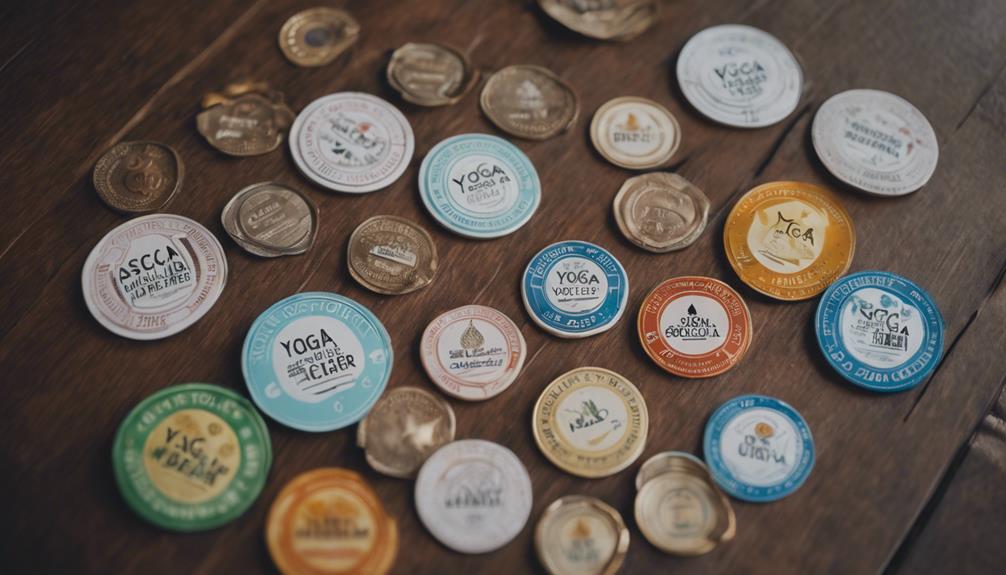How Much Do Yoga Teachers Make in Bali?
Bali, the yoga haven of Asia, beckons many with its serene landscapes and spiritual vibes, but does teaching yoga in Bali truly set a path paved with gold?
You've probably heard about the allure of a yoga teaching career in this paradise, but how much do yoga instructors actually earn here? The answer isn't as straightforward as you might think. It's influenced by various factors such as experience level, location, and type of class taught.
Hold on, as we're about to set on a journey to uncover the realities of a yoga teacher's income in Bali.
Key Takeaways
- Yoga teachers in Bali earn an average monthly income of $500 to $3,000, influenced by factors like experience, certifications, and teaching frequency.
- The dominant yoga styles in Bali, such as Vinyasa Flow and Hatha Yoga, impact income, with specialized certifications like Prenatal Yoga commanding higher salaries.
- Income for yoga instructors in Bali can fluctuate throughout the year due to peak tourist seasons, with private sessions offering a way to boost earnings.
- Strategic planning, marketing, and maintaining a balance between providing value to clients and fair compensation are crucial for maximizing income.
Understanding Yoga Teacher Salaries

To understand the salaries of yoga teachers in Bali, it's important to look into factors such as experience, location, type of yoga taught, and the number of classes conducted weekly. However, two essential elements often overlooked are 'Teacher Training Costs' and 'Yoga Insurance Expenses'. These aspects greatly influence the net income of yoga teachers, and hence, are important when calculating their salaries.
Each yoga style requires specific training, and the cost of these certifications varies. A teacher with advanced training in multiple yoga styles can demand higher fees, offsetting the initial training costs. On the other hand, a novice teacher, still recovering the training investment, might earn less.
Insurance forms another substantial expense. In a world increasingly conscious of legalities and safety, having yoga insurance is non-negotiable. It protects you from potential lawsuits resulting from injuries during classes. The cost of this insurance directly affects your bottom line, reducing your net income.
Innovative solutions to manage these expenses could include shared insurance programs or collaborative teacher training schemes. These could lessen the individual financial burden and potentially increase yoga teachers' net income in Bali.
Factors Affecting Income
In understanding the income of a yoga teacher in Bali, you'll find various factors at play, including the teacher's experience, the location and prestige of the yoga studio, and the frequency and size of the classes taught.
Teacher experience is a significant factor. You're likely to earn more as you acquire more experience and additional yoga specializations. Clients are prone to pay more for teachers who can offer specialized classes like Hot Yoga or Prenatal Yoga.
The location and prestige of your yoga studio also impact your earnings. Prestigious studios in prime locations like Seminyak or Ubud attract a higher-paying clientele, boosting your income.
Finally, the frequency and size of your classes matter. The more classes you teach, and the larger they are, the higher your income.
| Factor | Example | Impact |
|---|---|---|
| Teacher Experience | 10 years, Prenatal Yoga Specialization | Higher income |
| Location & Prestige | Studio in Seminyak | Higher income |
| Frequency & Size | 5 classes a day, 20 students per class | Higher income |
Bali's Yoga Industry Overview

As we turn our focus to Bali's yoga industry, understanding its market growth and the income factors for instructors is crucial.
The rise of yoga in Bali has created a vibrant and competitive market. Understanding the elements that influence a yoga teacher's income in this environment is key to grasping the full picture.
Bali's Yoga Market Growth
Bali's yoga industry has experienced significant growth over the years, transforming the island into a globally recognized yoga hub. This expansion is largely driven by Bali's wellness tourism and the spiritual significance of Yoga, attracting a diverse range of practitioners and teachers alike.
Here are some key factors that have contributed to the industry's growth:
- The rise of wellness retreats offering yoga classes and training
- Increased awareness of Yoga's spiritual and health benefits
- Bali's reputation as a spiritual and wellness sanctuary
- The influx of international yoga instructors bringing new styles and techniques
- The development of yoga-focused infrastructure, like studios and accommodation
Income Factors for Instructors
You might be wondering what factors influence the income of yoga instructors in Bali. Well, two important elements come into play: Teacher Training and Social Media Influence.
First and foremost, the level of teacher training greatly impacts income. Instructors with advanced qualifications often command higher pay rates. Additionally, those offering teacher training courses can gain a substantial revenue stream.
Next, the influence of social media can't be understated. Teachers with a strong online presence often attract larger class sizes and can leverage their popularity for higher earnings. They can also monetize their online platforms, offering virtual classes or personalized training plans.
As a result, your potential earnings as a yoga teacher in Bali depend largely on your qualifications and your ability to harness the power of social media.
Comparing Urban Vs Rural Earnings
When comparing the earnings of yoga teachers in Bali, you'll find a marked difference between urban and rural areas.
In bustling cities, yoga instructors often earn notably higher salaries than their rural counterparts.
This disparity in earnings is an important point to understand, especially if you're planning to teach yoga in Bali.
City-Based Yoga Instructors
In exploring the disparity between urban and rural earnings for yoga instructors, it's clear that city-based teachers in Bali often command higher salaries due to increased cost of living and demand for their services.
- Yoga franchising opportunities are plentiful in urban areas with a high concentration of potential clients.
- The instructor's lifestyle often involves networking and building relationships within the city's yoga community.
- Urban instructors might offer private lessons, which often pay more than group classes.
- They may also benefit from higher-priced workshops and retreats.
- Living in the city allows for more opportunities to increase income, such as teaching multiple classes in different studios.
Rural Yoga Instructor Earnings
While city-based yoga instructors often enjoy higher earnings, rural teachers in Bali face a different financial landscape. Costs like teaching materials and travel expenses can have a major impact on a rural instructor's income. Due to the geographical layout, you might find yourself traveling longer distances to reach your students, hiking up your travel expenses.
Additionally, teaching materials cost can be a real challenge. You're more likely to have fewer resources at your disposal, which means you may need to invest more in creating an appropriate teaching environment.
Furthermore, the potential client base in rural areas is typically smaller than in urban settings, affecting the overall income. However, innovation is key in these situations. By using local resources creatively, you can optimize your expenses and guarantee a sustainable teaching practice, even in rural Bali.
Disparity in Earnings
The earnings gap between urban and rural yoga instructors in Bali is a stark reality you'll face if you choose to teach in less populated regions of the island. Earnings transparency and salary negotiation are crucial factors that determine your income. Here's what you need to know:
- Urban instructors often earn more due to higher class rates and tourist clientele.
- Rural areas might offer lower salaries, but cost of living is also lower.
- Salary negotiation is crucial, especially in rural areas where rates aren't fixed.
- Earnings transparency can be elusive – do your research to understand local market rates.
- Consider other income sources like private classes or retreats to supplement your earnings.
Understanding these disparities will empower you to make informed career decisions and negotiate better pay.
Full-Time Vs Part-Time Incomes
Depending on whether you're teaching yoga full-time or part-time in Bali, your income can vary greatly. Full-time teachers typically have a higher income due to the larger number of classes they conduct. However, part-time teachers often have the flexibility to take on private clients or run workshops, which could potentially boost their earnings.
Tax implications are another factor to take into account. As a full-time teacher, you're more likely to be employed by a studio, which means taxes are usually deducted from your wages. On the other hand, as a part-time teacher or freelancer, you're responsible for your own tax payments, which can impact your net income.
Teacher training also plays a significant role in determining your earnings. A more advanced training allows you to command higher rates, especially for private lessons or specialized workshops.
Here's a brief overview:
| Full-Time/Part-Time | Average Monthly Income (USD) |
|---|---|
| Full-Time | $1,000 – $2,000 |
| Part-Time | $500 – $1,000 |
| Full-Time (with advanced training) | $2,000 – $3,000 |
| Part-Time (with advanced training) | $1,000 – $2,000 |
The choice between full-time and part-time teaching depends on your personal circumstances and career goals.
Impact of Certifications on Salary

In your journey as a yoga teacher, certifications can greatly affect your earning potential. Certifications not only increase your credibility but also play a substantial role in determining your salary. Let's explore further into this topic.
- Certification Types: There are various types of certifications that can boost your career as a yoga teacher. From a 200-hour Yoga Alliance certificate to advanced 500-hour certification, each level increases your expertise and income potential.
- Global Comparisons: Globally, the value of yoga certifications is recognized. Yoga teachers with certifications in Bali earn comparatively more than those without. For instance, in the USA, a certified yoga teacher makes approximately 24% more than a non-certified teacher.
- Specialized Certifications: Specialized certifications such as Prenatal Yoga or Therapeutic Yoga can often command a higher salary due to their specialized knowledge and skills.
- Experience: Along with your certification, your experience also impacts your earning potential. The more experience you have, the higher your salary can be.
- Reputation of Certification Body: Certifications from renowned and reputed institutions are more valued and can significantly increase your salary.
Popularity of Yoga Styles in Bali
As you look at Bali's yoga scene, you'll notice certain styles have a dominant presence, influencing both the types of classes available and the potential income for instructors.
However, there are also emerging trends that could offer new opportunities for both teachers and students.
Moreover, Bali's yoga retreats play a significant role in shaping the popularity of various styles, impacting teacher's earning potential.
Dominant Yoga Styles
You'll find a wide array of yoga styles gaining popularity in Bali, each with distinct teaching methods and philosophies. The styles reflect the latest yoga fashion trends and embrace the profound meditation benefits, making them appealing to both novices and seasoned practitioners.
The top five styles in Bali include:
- Vinyasa Flow: An innovative, fluid style that encourages movement synchronization with breath.
- Hatha Yoga: Known for its slower pace, it's perfect for beginners seeking to master basic postures.
- Ashtanga Yoga: A rigorous style that follows a precise sequence of postures.
- Yin Yoga: A calming, meditative style that holds poses for longer durations.
- Kundalini Yoga: A dynamic blend of physical postures, breathing techniques, meditation, and chanting.
Each style offers a unique blend of physical challenge and spiritual connection that contributes to the overall wellness of practitioners.
Emerging Yoga Trends
While these top five yoga styles continue to dominate the scene, let's not overlook the emerging trends that are reshaping the yoga landscape in Bali. Two standouts are yoga fashion trends and digital yoga platforms.
Yoga fashion trends highlight the fusion of style and comfort, with outfits that are both functional and chic. High-performance yoga wear is on the rise, blending Balinese aesthetics with modern design.
Digital yoga platforms are also gaining ground. They offer flexibility, allowing you to enjoy a Bali-inspired yoga session from anywhere in the world.
Here's a quick snapshot:
| Emerging Trends | Description |
|---|---|
| Yoga Fashion Trends | Fusion of style, comfort, Bali aesthetics, and modern design |
| Digital Yoga Platforms | Provides flexibility, Bali-inspired sessions accessible worldwide |
Stay tuned to these trends—they're shaping the future of yoga in Bali.
Bali's Yoga Retreats
Ever wondered which yoga styles are most popular in Bali's renowned yoga retreats? This paradise island offers a diverse range of yoga styles, deeply intertwined with Bali's meditation practices. Here's a peek at the top five:
- Hatha Yoga: Ideal for beginners, it's a great way to start your yoga journey.
- Vinyasa Yoga: Fast-paced and intense, it'll keep your heart rate up.
- Restorative Yoga: It's all about relaxation and healing.
- Ashtanga Yoga: A challenging style, perfect for those seeking a tougher routine.
- Kundalini Yoga: A blend of spiritual and physical practices.
The spiritual tourism impact has led to the flourishing of these styles. You'd not only improve your physical health but also get a taste of the rich spiritual heritage that Bali boasts of.
Income Fluctuations in Peak Seasons
During Bali's peak tourist season, the income of yoga teachers tends to increase significantly, reflecting the surge in demand for yoga classes. This seasonal migration of tourists, shaped largely by tourist demographics, dramatically influences the financial landscape for yoga instructors in Bali.
As throngs of health-conscious tourists flock to the island, classes fill up and more sessions are scheduled, leading to a boost in your earnings as a yoga teacher. However, these fluctuations can be volatile. One must be prepared for the quieter months when tourist numbers dwindle.
Let's illustrate this with a table:
| Season | Average Income of Yoga Teachers |
|---|---|
| Peak Season | High |
| Off-Peak Season | Modest |
| Transition Months | Variable |
| Average Annual | Stable |
This table paints a picture of income instability that can be stressful. However, it also highlights the potential for substantial earnings during peak seasons. It's a dynamic, ever-changing environment, but with strategic planning and innovative marketing, you can maximize your income potential throughout the year, whatever the season may bring.
Estimating Private Session Earnings

In addition to your income from group classes, you can also substantially boost your earnings by conducting private sessions. As we delve into estimating private session earnings, remember that your income highly depends on your Private Session Pricing and Marketing Strategies.
To start with, determining the right price for your private sessions can be tricky. Here are some factors you should consider:
- Your level of expertise and experience
- The average rates in the area
- The number of sessions per week
- The value you provide to your clients
- Your clients' ability to pay
You can't just randomly set a price; it must be strategically calculated to make sure you're adequately compensated for your time and effort while still providing value to your clients.
Next, Marketing Strategies. You've got to let people know about your services. Harness social media, engage with your community, offer introductory discounts, or referral bonuses. Be creative and innovative with your marketing strategies to attract more clients.
Additional Revenue Streams
Beyond group classes and private sessions, exploring additional revenue streams can greatly boost your overall income as a yoga teacher in Bali. One such stream that's rapidly growing in popularity is digital marketing. By developing an online presence you can reach a wider audience, promoting your yoga classes and workshops to both locals and tourists.
Consider setting up a website or a blog where you can share yoga tips, articles, and videos. You can also offer premium content like online classes or specialized yoga programs for a fee. Additionally, social media platforms, such as Instagram and Facebook, can be cleverly utilized for marketing and connecting with potential clients.
Another potential revenue stream is merchandise sales. As a yoga teacher, you can sell related products such as yoga mats, clothing, and books. This not only adds to your income but also strengthens your brand. You could even create your own product line! Remember, you're not just selling merchandise, you're providing your clients with resources that can enhance their yoga experience.
Cost of Living in Bali

While contemplating how much you could earn as a yoga teacher in Bali, it's important to factor in the island's cost of living, which can greatly impact your net income. To give you a clearer picture, let's delve deeper into some key expenses you'd likely encounter:
- Housing: Bali's housing market offers a range of options, from affordable shared accommodations to luxury villas. Your choice depends on your personal comfort and budget.
- Food: Indonesian cuisine costs are generally affordable. Local markets are a great source for fresh, inexpensive produce.
- Transportation: Most locals use scooters for their daily commute. Investing in one could be a cost-effective move.
- Utilities: Internet, water, and electricity bills are essential expenses to contemplate. These can add up, especially if you're living in a larger property.
- Healthcare: While generally inexpensive compared to Western countries, it's still important to budget for healthcare expenses.
Tips for Maximizing Earnings
To make the most of your earnings as a yoga teacher in Bali, it's important to strategize and implement effective methods for financial growth.
One aspect to take into account is the teaching materials cost. While it's tempting to invest in the latest yoga props and accessories, remember that these costs add up. Be innovative and creative in your approach. Use materials that are affordable yet effective in achieving the desired results for your classes. You might even contemplate creating your own materials.
The networking benefits in Bali's yoga community can also impact your earnings substantially. Actively engage in the community, attend events and workshops, and collaborate with other yoga teachers. This can lead to referral opportunities and even partnerships that can boost your income. Moreover, networking can open doors to teaching more exclusive classes or retreats, which tend to be more lucrative.
Don't forget to utilize social media and online marketing strategies. Having a strong online presence can attract more students and increase your visibility. Additionally, consider offering additional services like private classes or wellness consultations. These can add a significant boost to your earnings. Keep innovating and experimenting to find what works best for your yoga business in Bali.



